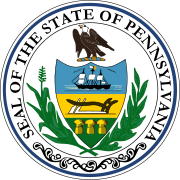1991 United States Senate special election in Pennsylvania
| |||||||||||||||||
| |||||||||||||||||
 County results Wofford: 50–60% 60–70% 70–80% Thornburgh: 50-60% 60-70% 70-80% | |||||||||||||||||
| |||||||||||||||||
| Elections in Pennsylvania |
|---|
 |
|
|
The 1991 United States Senate Special election in Pennsylvania was held on November 5, 1991, after incumbent Republican Senator John Heinz died in a plane crash on April 4 of that year. Democrat Harris Wofford was appointed to the seat by Governor Bob Casey, and won the general election over Republican Dick Thornburgh, a former Governor and U.S. Attorney General. Wofford became Pennsylvania's first Democratic Senator since Joseph S. Clark Jr. left office in 1969. Major-party candidates for this election were chosen by party committees, as the vacancy had happened too late for a primary to be held.
Major candidates[]
Democratic[]
- Harris Wofford, incumbent U.S. Senator and former State Secretary of Labor
Republican[]
- Dick Thornburgh, former Governor and U.S. Attorney General
Campaign[]
House Majority Whip William H. Gray was a potential candidate for the Democrats, but he declined to run and surprisingly resigned from Congress in 1991 to serve as President of the United Negro College Fund from 1991 to 2004. The move was considered a complete surprise and prompted questions as to why he had done so. There was widespread speculation that he had been the subject of an investigation into alleged campaign finance irregularities and a grand jury investigation into his church's financial dealings. He was reported to have struck a deal with Republican Dick Thornburgh, the United States Attorney General and former Governor of Pennsylvania, that he would not run in the special election and in return Thornburgh would drop the investigation into him.[1][2][3][4][5]
Incumbent Senator Wofford's win was impressive because as little as five months before the election, his own internal polls showed him trailing Thornburgh by upwards of 40 points. Both the state and national Democratic establishment were tepid toward Wofford's campaign, feeling that Governor Casey had missed a prime opportunity to select a top tier candidate and had instead created a situation where Republicans would take back the seat just months after losing it. In conjunction with his fundraising issues, Wofford also had difficulty communicating his message to the voters; because he had a bureaucratic as opposed to a political background, he spoke in a somewhat long-winded manner that received criticism in the media. With his large lead in the polls, Thornburgh laid back to avoid mistakes, which allowed Wofford to gain traction. Despite his elite upbringing, Wofford connected well with working class voters as he made access to healthcare a huge plank of his campaign. He also successfully derided Thornburgh for his connections to the president, as Bush's popularity was steeply declining due to a recession.[6][7]
Thornburgh was unable to mount credible attacks against Wofford until after the Democrat had already established himself. As a result, Wofford was not only victorious in traditionally Democratic areas, such as Philadelphia city, Scranton, and metro Pittsburgh, but he also ran well in GOP strongholds. Wofford won three of the four suburban Philadelphia counties, which, although socially liberal, were strongly aligned with Republicans; the "roll-up-your-sleeves" style campaign ran by Wofford also allowed him to perform stronger than most Democrats in rural regions and to even win several usually Republican counties with a strong labor base.[7]
Wofford's victory proved to be a harbinger for Bill Clinton's victory in the presidential election held a year later. Wofford's campaign was run by Paul Begala and James Carville, who would go on to play key roles in the Clinton campaign.[citation needed] Democrats did very well across the state including in Allegheny County (Pittsburgh) and Philadelphia County (Philadelphia).[citation needed]
Results[]
| Party | Candidate | Votes | % | ±% | |
|---|---|---|---|---|---|
| Democratic | Harris Wofford (Incumbent) | 1,860,760 | 55.01% | ||
| Republican | Dick Thornburgh | 1,521,986 | 44.99% | ||
| Majority | 338,774 | 10.01% | -23.99% | ||
| Total votes | 3,382,746 | 100.00% | |||
See also[]
- 1990 United States Senate elections
References[]
- ^ "Did Dick Cut Bill A Deal? Book: Thornburgh Had Goods On Gray - Philly.com". Articles.philly.com. March 25, 2011. Retrieved July 26, 2013.
- ^ Moore, Alexis (June 20, 1991). "Why Would Gray Resign? Several Ideas Are Floated - Philly.com". Articles.philly.com. Retrieved July 26, 2013.
- ^ "Thornburgh Aide Linked to Gray Leak : Congress: A Justice Department probe says the chief spokesman and an ex-FBI official confirmed a damaging report on House Democratic leader. - Los Angeles Times". Articles.latimes.com. April 20, 1990. Retrieved July 26, 2013.
- ^ Stone, Chuck (June 13, 1990). "Editorials & Opinion | The Conniving Ways Of Dick Thornburgh | Seattle Times Newspaper". Community.seattletimes.nwsource.com. Retrieved July 26, 2013.
- ^ Wasniewski, Matthew (August 27, 2012). Black Americans in Congress, 1870-2007 - Google Books. ISBN 9780160801945. Retrieved July 26, 2013.
- ^ Michael DeCourcy Hinds (November 6, 1991). "Wofford Wins Senate Race, Turning Back Thornburgh; G.O.P. Gains Edge In Trenton". The New York Times.
- ^ Jump up to: a b Kennedy, John J. (2006). Pennsylvania elections : statewide contests from 1950-2004. Lanham, Md.: University Press of America. pp. 68–70. ISBN 0761832793.
- 1991 United States Senate elections
- United States Senate elections in Pennsylvania
- United States Senate special elections
- Pennsylvania special elections
- 1991 Pennsylvania elections
- Special elections to the 102nd United States Congress

